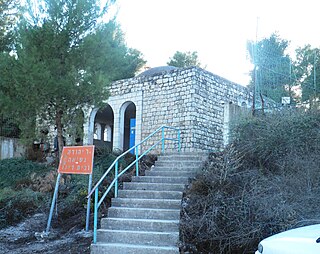Related Research Articles

Judah II or Nesi'ah I was a famous Jewish sage who lived in Tiberias in the Land of Israel, in the middle of the third century CE.
The av beit din, also spelled av beis din or abh beth din and abbreviated ABD, was the second-highest-ranking member of the Sanhedrin during the Second Temple period, and served as an assistant to the Nasi (Prince). The Av Beit Din was known as the "Master of the Court;" he was considered the most learned and important of these seventy members.
Jose ben Halafta or Yose ben Halafta was a tanna of the fourth generation. He is the fifth most frequently mentioned sage in the Mishnah. Of the many Rabbi Yose's in the Talmud, Yose Ben Halafta is the one who is simply referred to as Rabbi Yose.
Jose b. Abin was a Jewish Talmudist, known as an amora of the fifth generation who lived in the Galilee in the Land of Israel. He was the son of Rabban Abin I and the teacher of Abin II. He was at first the pupil of Rabbi Jose of Yodqart, but the latter's indifference to his own family caused Jose to leave him and follow Assi. Jose was the most important among the last Halakhists of the amoraim of the Land of Israel. He had a thorough knowledge not only of the Judean customs and halakhot, but of the Babylonian, a fact that has led some scholars to maintain that Jose must have resided at some time in Babylonia. It is probable, however, that he derived his knowledge of Babylonian teaching from his father, who had traveled in Babylonia.
Moses Nagari or Moses ben Judah (in Hebrew, Moshe ben Yehuda ha-Nagari was a medieval Jewish philosopher and writer. According to Steinschneider, he lived at Rome, Italy about 1300, and his name should be read "Na'ar", part of the Ne'arim family. Moses wrote Ma'amar ba-Ma'areket, an index to Maimonides' Moreh Nebukim, and explanations of philosophical terms, printed, together with Saul Cohen's philosophical questions on the "Moreh" addressed to Isaac Abravanel, at Venice in 1574. This being considered a fragment of a collective work on the Moreh, it was erroneously called Qetzat Bi'ure ha-Moreh.
Jose ben Aqabya was a rabbi and Tanna whose career spanned the early third century CE. The name "Issi" or "Assa" is derived from "Jose," and was borne by many tannaim and amoraim; hence the confusion that prevails in the Talmud concerning the identity of each of them, the same halakhic or aggadic saying being attributed sometimes to one and sometimes to another of that name. Thus the prohibition against riding on a mule is reported in the Yerushalmi in the name of Issi ben Aqabya, while in the Tosefta it is attributed to Issi ha-Babli, who is undoubtedly identical with Issi ben Judah. Bacher supposes that Issi ben Aqabya was the brother of Hananiah ben Aqabya, the interpreter ("meturgeman") of Judah ha-Nasi. Issi was a diligent student of the Bible, and some of his interpretations have been preserved in the midrashic literature.
Abba bar Abba was a Jewish Talmudist who lived in Babylonia in the 2nd-3rd centuries.

Levi ben Sisi or Levi bar Sisi was a Jewish scholar, one of the semi-tannaim of the late 2nd century and early 3rd century.
Epes the Southerner or Rabbi Epes, was a scholar of the 3rd century, secretary to the patriarch Judah haNasi, and one of the last tannaim. After Judah's death, while Efes conducted a college in southern Judea, on account of which he was called "EfesDaromi", he was made head of the academy at Sepphoris, although the dying patriarch had ordered the appointment of Hanina b. Hama to that position. Hanina refused to supersede Efes, who was his senior by two years and a half.
Joshua ben Levi was an amora, a scholar of the Talmud, who lived in the Land of Israel in the first half of the third century. He lived and taught in the city of Lod. He was an elder contemporary of Johanan bar Nappaha and Resh Lakish, who presided over the school in Tiberias. With Johanan bar Nappaha, he often engaged in homiletic exegetical discussions.
Nathan the Babylonian, also known as Rabbi Nathan, was a tanna of the third generation.
Pinchas ben Yair was a Tanna of the 4th generation who lived, probably at Lod, in the late 2nd century. He was the father-in-law of Shimon bar Yochai and a fellow disciple of Judah haNasi. He was more celebrated for piety than for learning, although his discussions with his son-in-law demonstrate great sagacity and a profound knowledge of tradition.
Ishmael ben Jose was a rabbi who lived at the beginning of the 3rd century. He was the son of Jose ben Halafta.
Eliezer ben Jacob I was a Tanna of the 1st century; contemporary of Eleazar Chisma and Eliezer ben Hyrcanus, and senior to Judah ben Ilai.
Isaac ben Merwan ha-Levi was a Provençal rabbi and Talmudist; he was the elder son of Merwan of Narbonne.

Abba Saul was a fourth generation Tanna.
Joshua Ben Karha (Hebrew: יהושע בן קרחה, Yehoshua ben Karcha, was a Jewish Tanna sage of the fourth generation.
Jose ben Judah was a rabbi who lived at the end of the 2nd century CE.
Rabbi Yannai was an amora who lived in the 3rd century, and of the first generation of the Amoraim of the Land of Israel.
Hananiah ben Akavia was a rabbi of the second century.
References
- Saul Schechter, Solomon and A.S. Waldstein. "Jose b. Saul." Jewish Encyclopedia . Funk and Wagnalls, 1901-1906, citing:
- Bacher, Ag. Pal. Amor. iii. 598;
- Heilprin, Seder ha-Dorot, ii. 221, Warsaw, 1882.
![]()